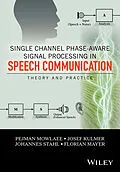An overview on the challenging new topic of phase-aware signal processing
Speech communication technology is a key factor in human-machine interaction, digital hearing aids, mobile telephony, and automatic speech/speaker recognition. With the proliferation of these applications, there is a growing requirement for advanced methodologies that can push the limits of the conventional solutions relying on processing the signal magnitude spectrum.
Single-Channel Phase-Aware Signal Processing in Speech Communication provides a comprehensive guide to phase signal processing and reviews the history of phase importance in the literature, basic problems in phase processing, fundamentals of phase estimation together with several applications to demonstrate the usefulness of phase processing.
Key features:
* Analysis of recent advances demonstrating the positive impact of phase-based processing in pushing the limits of conventional methods.
* Offers unique coverage of the historical context, fundamentals of phase processing and provides several examples in speech communication.
* Provides a detailed review of many references and discusses the existing signal processing techniques required to deal with phase information in different applications involved with speech.
* The book supplies various examples and MATLAB® implementations delivered within the PhaseLab toolbox.
Single-Channel Phase-Aware Signal Processing in Speech Communication is a valuable single-source for students, non-expert DSP engineers, academics and graduate students.
Autorentext
Pejman Mowlaee, Graz University of Technology, Austria
Dr. Mowlaee is a Senior Research and Teaching Associate at the Speech Communication and Signal Processing Laboratory, Graz University of Technology, Austria. He has received several awards including best M.Sc. thesis, awarded by the National Scientific Students' Organization of Electrical Engineering in 2007; and was a member of the organizing committee for the annual European Signal Processing Conference in 2010 in Aalborg and AUDIS workshop 2012 in Aachen. He has contributed over 40 journal and conference articles; he is a senior member of IEEE, acted as a reviewer for a number of journals, and has played an active role in organizing special sessions on the topic of the book at INTERSPEECH conferences. Dr. Mowlaee is also Guest Editor for the forthcoming Special Issue in Speech Communication (Elsevier) on Phase-Aware Signal Processing for Speech Communication.
Johannes Stahl, Graz University of Technology, Austria
In 2009, Johannes started studying Electrical Engineering and Audio Engineering, at Graz University of Technology. In 2015, he received his Dipl.-Ing. (MSc) degree with distinction. In 2015 he joined the Signal Processing and Speech Communication Laboratory, at Graz University of Technology, where he is currently pursuing his PhD thesis in the field of speech processing.
Josef Kulmer, Graz University of Technology, Austria
Josef received the M.Sc. degree from Graz University of Technology, Austria, in 2014. In 2014 he joined the Signal Processing and Speech Communication Laboratory, at Graz, University of Technology, where he is currently pursuing his PhD thesis in the field of signal processing.
Florian Mayer, Graz University of Technology, Austria
In 2006, Florian started studying Electrical Engineering and Audio Engineering, at Graz University of Technology, and received his Dipl.-Ing. (MSc) in 2015. In 2015 he joined the Signal Processing and Speech Communication Laboratory, at Graz University of Technology, where he is currently pursuing his PhD thesis in the field of speech processing.
Inhalt
About the Authors xi
Preface xiii
List of Symbols xvii
Part I History, Theory and Concepts 1
1 Introduction: Phase Processing, History 3
Pejman Mowlaee
1.1 Chapter Organization 3
1.2 Conventional Speech Communication 3
1.3 Historical Overview of the Importance or Unimportance of Phase 6
1.4 Importance of Phase in Speech Processing 9
1.4.1 Speech Enhancement 9
1.4.1.1 Unimportance of Phase in Speech Enhancement 10
1.4.1.2 Effects of Phase Modification in Speech Signals 10
1.4.1.3 Phase Spectrum Compensation 10
1.4.1.4 Phase Importance for Improved Signal Reconstruction 11
1.4.2 Speech Watermarking 11
1.4.3 Speech Coding 12
1.4.4 Artificial Bandwidth Extension 13
1.4.5 Speech Synthesis 14
1.4.6 Speech/Speaker Recognition 15
1.5 Structure of the Book 16
1.6 Experiments 18
1.6.1 Experiment 1.1: Phase Unimportance in Speech Enhancement 18
1.6.2 Experiment 1.2: Effects of Phase Modification 20
1.6.3 Experiment 1.3: Mismatched Window 22
1.6.4 Experiment 1.4: Phase Spectrum Compensation 24
1.7 Summary 26
References 26
2 Fundamentals of Phase-Based Signal Processing 33
Pejman Mowlaee
2.1 Chapter Organization 33
2.2 STFT Phase: Background and Some Remarks 33
2.2.1 Short-Time Fourier Transform 33
2.2.2 Fourier Analysis of Speech: STFT Amplitude and Phase 34
2.3 Phase Unwrapping 35
2.3.1 Problem Definition 35
2.3.2 Remarks on Phase Unwrapping 38
2.3.3 Phase Unwrapping Solutions 38
2.3.3.1 Detecting Discontinuities 39
2.3.3.2 Numerical Integration (NI) 40
2.3.3.3 Isolating Sharp Zeros 41
2.3.3.4 Iterative Phase Unwrapping 41
2.3.3.5 Polynomial Factorization (PF) 42
2.3.3.6 Time Series Approach 42
2.3.3.7 Composite Method 43
2.3.3.8 SchurCohn and Nyquist Frequency 44
2.4 Useful Phase-Based Representations 44
2.4.1 Group Delay Representations 45
2.4.2 Instantaneous Frequency 48
2.4.3 Baseband Phase Difference 49
2.4.4 Harmonic Phase Decomposition 50
2.4.4.1 Background on the Harmonic Model 50
2.4.4.2 Phase Decomposition using the Harmonic Model 51
2.4.5 Phasegram: Unwrapped Harmonic Phase 52
2.4.5.1 Definitions and Background 52
2.4.5.2 Circular Mean and Variance 52
2.4.6 Relative Phase Shift 53
2.4.7 Phase Distortion 54
2.5 Experiments 57
2.5.1 Experiment 2.1: One-Dimensional Phase Unwrapping 57
2.5.1.1 Clean Signal Scenario 57
2.5.1.2 Noisy Signal Scenario 58
2.5.2 Experiment 2.2: Comparative Study of Phase Unwrapping Methods 58
2.5.3 Experiment 2.3: Comparative Study on Group Delay Spectra 59
2.5.4 Experiment 2.4: Circular Statistics of the Harmonic Phase 60
2.5.5 Experiment 2.5: Circular Statistics of the Spectral Phase 62
2.5.6 Experiment 2.6: Comparative Study of Phase Representations 63
2.6 Summary 65
References 65
3 Phase Estimation Fundamentals 71
Josef Kulmer and Pejman Mowlaee
3.1 Chapter Organization 71
3.2 Phase Estimation Fundamentals 71
3.2.1 Background and Fundamentals 71
3.2.2 Key Examples: Phase Estimation Problem 72
3.2.2.1 Example 1: Discrete-Time Sinusoid 72
3.2.2.2 Example 2: Discrete-Time Sinusoid in Noise 76
3.2.3 Phase Estimation 80
3.2.3.1 Maximum Likelihood Estimation 80
3.2.3.2 Maximum a Posteriori Estimation 83
3.3 Existing Solutions 84
3.3.1 Iterative Signal Reconstruction 84
3.3.1.1 Background 84
3.3.1.2 GriffinLim Algorithm (GLA) 85
3.3.1.3 Extensions of the GLA 87
3.3.2 Phase Recons...
